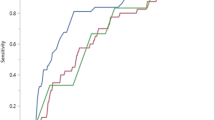Abstract
Purpose
Evaluate whether morbid obesity influenced resolution, number of doses or ultimately surgical management of tubal ectopic pregnancy (TEP) when treated with single-dose regimen methotrexate (SDR-MTX) capped at 100 mg.
Methods
Retrospective cohort study of patients with a diagnosis of TEP who underwent MTX treatment from 2000 to 2013. Patients were excluded if initial β–hCG <1000 mIU/mL, did not have β–hCG follow-up or were not treated with SDR-MTX. Per protocol, dose was administered at 50 mg/m2 with a capped maximum of 100 mg. Patients were divided based on their BMI (<40 and ≥40 kg/m2). Demographic variables, β–hCG before treatment, maximum diameter of ectopic size, embryonic heart tones, decrease of β–hCG, need for additional MTX doses and surgery despite treatment were recorded and compared among the groups.
Results
151 women were included in the study, 89.4% (135/151) non-morbidly obese and 10.6% (16/151) morbidly obese. No differences in age distribution, ethnicity, pre-treatment presence of embryonic heart tones, maximum diameter of ectopic size ≥35 mm and β–hCG ≥5000 mIU/ml were found. Following treatment, the proportion of patients with at least an 80% decrease in their β–hCG levels or need for surgery were similar, however, morbidly obese patients were significantly more likely [11/134 vs. 5/16, OR 5.1 (1.5–17.3, p = 0.015)] to require an additional MTX dose.
Conclusion
Among patients with TEP, morbidly obese patients were five times more likely to require an additional dose compared to non-morbidly obese when SDR-MTX capped at 100 mg was used for medical management.

Similar content being viewed by others
References
Chang J, Elam-Evans LD, Berg CJ, Herndon J, Flowers L, Seed KA, Syverson CJ (2003) Pregnancy-related mortality surveillance–United States, 1991–1999. MMWR Surveill Summ 52(2):1–8
Kadar N, Romero R (1982) The timing of a repeat ultrasound examination in the evaluation for ectopic pregnancy. J Clin Ultrasound 10(5):211–214
Kadar N, Taylor KJ, Rosenfield AT, Romero R (1983) Combined use of serum HCG and sonography in the diagnosis of ectopic pregnancy. AJR Am J Roentgenol 141(3):609–615. doi:10.2214/ajr.141.3.609
Lipscomb GH (2012) Medical management of ectopic pregnancy. Clin Obstet Gynecol 55(2):424–432. doi:10.1097/GRF.0b013e3182510a48
Gynecologists ACoOa (2008) ACOG Practice Bulletin No. 94: Medical management of ectopic pregnancy. Obstet Gynecol 111(6):1479–1485. doi:10.1097/AOG.0b013e31817d201e
Morlock RJ, Lafata JE, Eisenstein D (2000) Cost-effectiveness of single-dose methotrexate compared with laparoscopic treatment of ectopic pregnancy. Obstet Gynecol 95(3):407–412
Barnhart KT, Gosman G, Ashby R, Sammel M (2003) The medical management of ectopic pregnancy: a meta-analysis comparing “single dose” and “multidose” regimens. Obstet Gynecol 101(4):778–784
Farquhar CM (2005) Ectopic pregnancy. Lancet 366(9485):583–591. doi:10.1016/S0140-6736(05)67103-6
Barnhart KT (2009) Clinical practice. Ectopic pregnancy. N Engl J Med 361(4):379–387. doi:10.1056/NEJMcp0810384
Ratain MJ (1998) Body-surface area as a basis for dosing of anticancer agents: science, myth, or habit? J Clin Oncol 16(7):2297–2298
Pai MP (2012) Drug dosing based on weight and body surface area: mathematical assumptions and limitations in obese adults. Pharmacotherapy 32(9):856–868. doi:10.1002/j.1875-9114.2012.01108.x
Ogden CL, Carroll MD, Kit BK, Flegal KM (2014) Prevalence of childhood and adult obesity in the United States, 2011–2012. JAMA 311(8):806–814. doi:10.1001/jama.2014.732
Flegal KM, Carroll MD, Kit BK, Ogden CL (2012) Prevalence of obesity and trends in the distribution of body mass index among US adults, 1999–2010. JAMA 307(5):491–497. doi:10.1001/jama.2012.39
Knibbe CA, Brill MJ, van Rongen A, Diepstraten J, van der Graaf PH, Danhof M (2015) Drug disposition in obesity: toward evidence-based dosing. Annu Rev Pharmacol Toxicol 55:149–167. doi:10.1146/annurev-pharmtox-010814-124354
Department of Health GoSA South Australian Perinatal Practice Guidelines Ectopic Pregnancy. https://www.sahealth.sa.gov.au/wps/wcm/connect/fead0f004ee4554cb7ecbfd150ce4f37/Ectopic-pregnancy-WCHN-PPG-01092008.pdf?MOD=AJPERES&CACHEID=fead0f004ee4554cb7ecbfd150ce4f37. Accessed June 23 2015
Mavrelos DMM, Helmy S, Derdelis G, Jauniaux E (2015) Jurkovic D (2015) β-hCG resolution times during expectant management of tubal ectopic pregnancies. BMC Womens Health 15(1):43
Mavrelos DNH, Jamil A, Hoo W, Jauniaux E, Jurkovic D (2013) Efficacy and safety of a clinical protocol for expectant management of selected women diagnosed with a tubal ectopic pregnancy. Ultrasound Obstet Gynecol 42(1):102–107
Griggs JJ, Mangu PB, Anderson H, Balaban EP, Dignam JJ, Hryniuk WM, Morrison VA, Pini TM, Runowicz CD, Rosner GL, Shayne M, Sparreboom A, Sucheston LE, Lyman GH, Oncology ASoC (2012) Appropriate chemotherapy dosing for obese adult patients with cancer: American Society of Clinical Oncology clinical practice guideline. J Clin Oncol 30(13):1553–1561. doi:10.1200/JCO.2011.39.9436
Sandhu G, Mapp S, Carrington C, Hennig S (2014) To cap or not to cap: chemotherapy dosing in obese adult hematology patients. Clin Pharmacol Ther 95(4):356–358. doi:10.1038/clpt.2014.3
Yalcinkaya TM, Brown SE, Mertz HL, Thomas DW, DePond RT, Heywood ER (2000) A Comparison of 25 mg/m2 Vs 50 mg/m2 Dose of Methotrexate (MTX) for the Treatment of Ectopic Pregnancy (EP). J Soc gynecol Invest. 7(1):179A
Author information
Authors and Affiliations
Corresponding author
Ethics declarations
No funding as obtained for this study.
Conflict of interest
LR Hoyos declares that he has no conflict of interest. MF Malik declares that she has on conflict of interest. M Najjar declares that he has no conflict of interest. J Rodriguez-Kovacs declares that he has no conflict of interest. M Abdallah declares that he has no conflict of interest. G Vilchez declares that he has no conflict of interest. AO Awonuga declares that he has no conflict of interest.
Ethical approval
This article does not contain any studies with human participants or animals performed by any of the authors.
Rights and permissions
About this article
Cite this article
Hoyos, L.R., Malik, M., Najjar, M. et al. Morbid obesity and outcome of ectopic pregnancy following capped single-dose regimen methotrexate. Arch Gynecol Obstet 295, 375–381 (2017). https://doi.org/10.1007/s00404-016-4229-0
Received:
Accepted:
Published:
Issue Date:
DOI: https://doi.org/10.1007/s00404-016-4229-0




